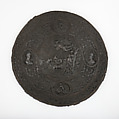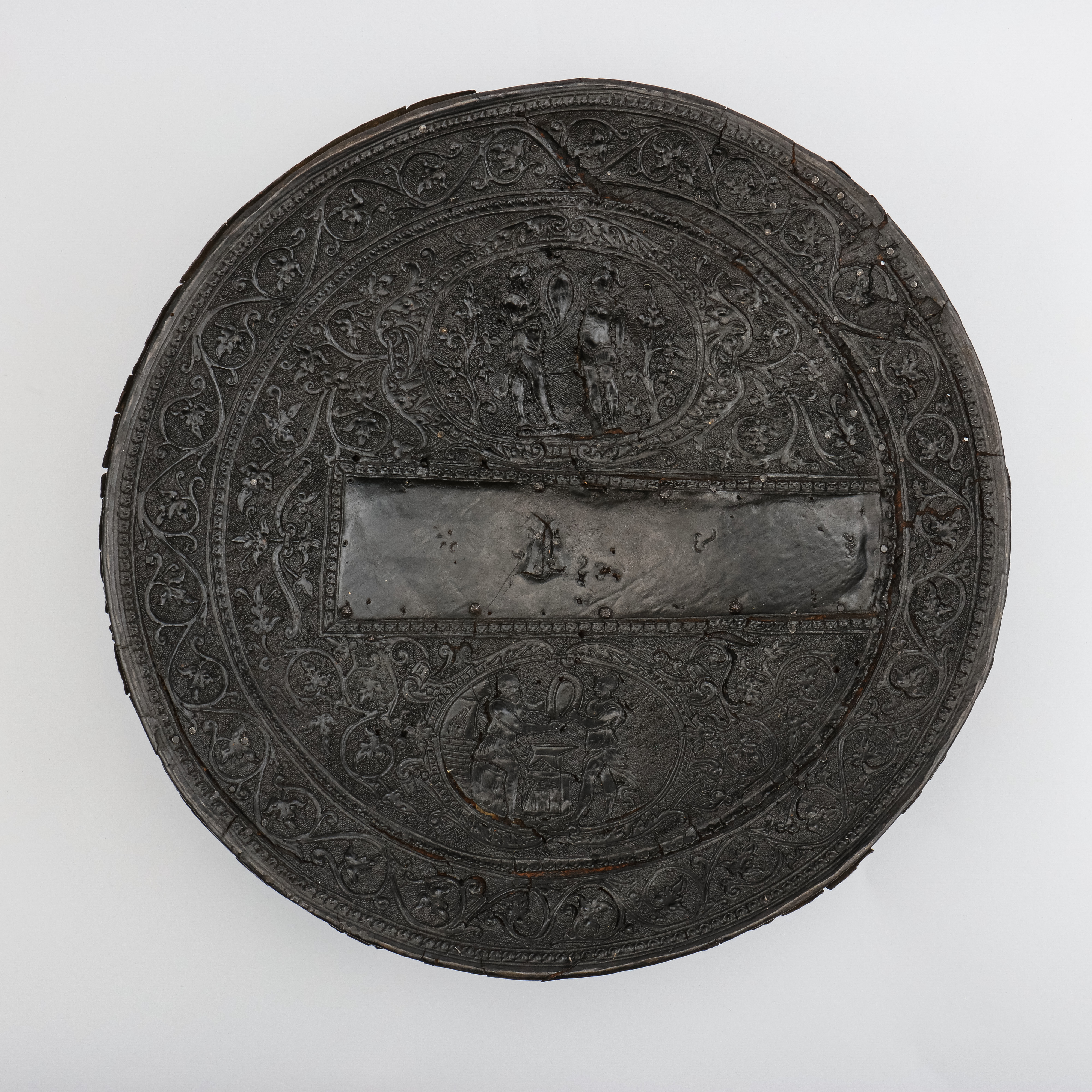Embossed Shield
Not on view
This shiled is formed of a circular base of wood, convex in section, and covered on both sides with black leather embossed in low relief and tooled. The decoration on the front is organized into three fields consisting of two concentric bands enclosing a large circular center, each band framed with a laurel wreath. The center area contains a scene of the hero Perseus rescuing the maiden Andromeda from the dragon (Ovid, Metamorphoses, IV). Above Perseus are the letters S L. The wreath surrounding the center field extends out to the next concentric band in four loops which form medallions depicting a satyr holding a trumpet (above), Hercules and the Nemean lion (below), and two bust-length profile figures of a man in armor and a woman (at the right and left sides respectively). Between the medallions and in the outermost band the space is filled with entrwined foliate strapwork.
The decoration on the inside of the shield is organized into a large circular field at the center, surrounded by a single concentric band decorated with foliate sscrolls, the two fields framed by narrow bands of stylized palmettes. The central field has an undecorated oblong panel, set slightly to right of center, which held the arm pad and straps for the forearm and hand, now lost; six iron rivets in the form of rosettes, which secured the arm pad, are preserved. Within this undecorated area there are random toolmarks, apparently made by the leather worker to test his tools. Above and below this section are horizontally elongated oval medallions framed by scrollwork and enclosing scenes of Hephaestus presenting Thetis with a shield (below), and Thetis presenting the shield to her son Achilles (Homer, Iliad, XVIII–XIX); the areas between the medallions and undecorated section are filled with foliate scrolls.
This shield belongs to a large and distinctive group of embossed leather objects made in Italy in the sixteenth century, which includes chests and boxes of various types, as well as shields, helmets, scabbards for swords and daggers, and powder flasks (see acc. no. 19.53.89). In the process of manufacture (known as cuir bouilli, boiled leather in French; cuoio cotto, cooked leather in Italian), the leather was first softened and then incised on the exterior with the design, which was raised in low relief by pressure applied from the back. The finer details of the design were added by working again on the front surface, and the background of the decoration was punched for contrast. When the entire surface was then subjected to heat, the leather hardened and preserved the design. The process of working and decorating these leather objects was analogous to the embossing of iron, but was, of course, undertaking by specialized leather workers rather than armorers or goldsmiths. These shields and helmets of embossed leather, like their iron counterparts, were intended for parade rather than for battle.
In spite of their survival in large numbers, surprisingly little is known about the origin of these shields. Their place of manufacture has been ascribed by Gall to Milan, but without documentation, and except for two shields in London and Offenbach inscribed with the initials B P, presumably those of the craftsman, their authorship remains anonymous. (The letters S L found on the front of our shield are too large and conspicuous to be a craftsman's signature and, more likely, refer to the name or motto of the shield's owner, not as yet identified.) L. G. Boccia has recently suggested that an embossed leather shield bearing the portrait of Duke Alessandro de' Medici (Museo Nazionale del Bargello, Florence, inv. no. M. 758) is of Florentine manufacture. If this is indeed the case, the entire group of these shields may also have originated in Florence, a city still renowned for its leatherwork. A shield decorated with identical subject matter and exhibiting the same workmanship as this shield is now also in the Museo Nazionale del Bargello (inv. no. M. 757; formerly in the Medici armory); presumably both were made by the same master.
Due to rights restrictions, this image cannot be enlarged, viewed at full screen, or downloaded.
This artwork is meant to be viewed from right to left. Scroll left to view more.




